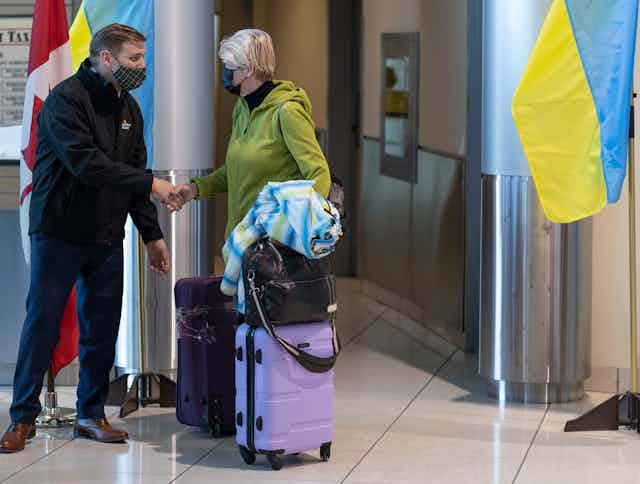“When we talk about systemic racism, we’re not talking about what the government intended; we’re looking at outcomes — and the outcomes speak for themselves,” says Sharry Aiken, a law professor at Queen’s University in Kingston, Ont.
Since Afghanistan was forcibly returned to Taliban rule nine months ago, Canada has approved only 13,000 Afghan refugee applications for immigration.
In contrast, eight times that number of Ukrainians have been approved under the Canada-Ukraine Emergency Authorization for Emergency Travel (CUAET) program in the few weeks since Russia invaded Ukraine in February.
The processes for Afghan and Ukrainian refugees are different and operate at different speeds because the political climates of their respective countries are different, says Rémi Larivière, a media relations adviser at Immigration, Refugees and Citizenship Canada (IRCC).
But Anna Triandafyllidou, a professor and Canada Excellence Research Chair at Toronto Metropolitan University, says that’s not the entire story. She says that seeing such disparate treatment of Ukrainians compared with other refugees reflects unfairness in our immigration process — treatment that others say may result from systemic racism and pressure from diasporas.

Inequity has many root causes
When asked why Canada offers one process for Ukrainians and another for Afghans, “we really don’t have an answer,” says Usha George, director of the Toronto Metropolitan Centre for Immigration and Settlement.
Aiken says the fact that Afghans are racialized but Ukrainians are not may play a role in this disparity. However, George says there’s more nuance to this: “It’s easy to say that it’s just racism but that’s an oversimplification.”
George says that over time, the Canadian public has lost sensitivity to the human suffering going on in Afghanistan. By contrast, Russia’s invasion of Ukraine, without regard to treaties or human rights, “strikes people at the very core of their being” — giving Canada no choice but to act.
Then there’s political pressure from the Ukrainian diaspora in Canada, which George says is also a factor. In Canada, there are 1.3 million people of Ukrainian descent, but only 84,000 of Afghan origin, according to the 2016 census.
Vastly different immigration experiences
For Olga Charnetska, a 49-year-old event company owner in Kyiv, the CUAET process has been relatively quick.
Within weeks of applying for emergency travel authorization for her husband and two younger children, they were approved on May 6. Charnetska and her family flew to Toronto on May 18, where they were met by her two older daughters who already live here.
Larivière explains that CUAET “is not a refugee program.” Instead, it uses an existing temporary-resident visa process to quickly bring as many Ukrainians as possible to Canada. Their stay is meant to be temporary while the situation in Ukraine unfolds, and then they return home.
However, Larivière’s written statement does not explain why the same process couldn’t be used for Afghans instead of the current refugee process, which leaves many to suffer in limbo.
Recently caught in that limbo is Najib Zafar, who was an interpreter for the Canadian Forces in Kandahar, Afghanistan.
For seven months, Zafar and his family hid from the Taliban in Afghanistan as they waited for Canadian documents to facilitate their escape to Pakistan.

When the family finally was able to leave, “it took nine hours of inch-by-inch walking and pushing to reach the border,” says Zafar.
“It was too hot and too loud. My wife was sick. The Taliban knew that we had worked for foreigners and that we were fleeing, so they treated us with a great degree of cruelty,” he says. “They would beat anyone — whether a kid, an adult or elderly.”
Zafar and his family were kept waiting an additional two months in Islamabad before the Canadian government finally flew them to Calgary on April 5, 2022. But he considers himself among the fortunate.
“There are people who have been waiting for five months in Pakistan now. No one cares. No health care is provided there,” he says.
Other differences
Triandafyllidou says that Afghans are going through “nine degrees of security scrutiny” compared with Ukrainians, slowing down their application process.
Also notable is the lack of a limit to the number of applicants who can be approved under the CUAET program, compared with the government’s goal of admitting 40,000 Afghan refugees. Triandafyllidou says this is the first time Canada has not capped an immigration program for refugees.
“The thinking is that this will be a group that will be easily absorbed into Canadian society,” she says.
However, not all differences in the two programs work to Ukrainians’ advantage. Triandafyllidou explains that Afghan refugees resettle as family units and can later add on other family members from abroad to their original applications, facilitating reunification in Canada.
In contrast, most Ukrainians coming to Canada are women, children and older people who left behind male relatives aged 18 to 60, who cannot leave Ukraine due to mandatory conscription. These immigrants may have to return to Ukraine if they want a family reunion.

Bridging the gap
When it comes to bridging the gap between how we treat different groups of refugees, Triandafyllidou suggests: “Maybe what we should do is be more generous towards Afghans. Two wrongs are not going to make one right.”
George says the government should aim to be proactive to refugee crises rather than just reacting to political pressure and the visibility of an issue. “There is no use of previous lessons and experiences to create a better system,” she says.
Read more: The unprecedented Ukraine-to-Canada 'air bridge' could mean a brighter future for all refugees
In the end, Zafar says, Afghans just want to be treated fairly. “We’re also humans and deserve equal treatment,” he says.
“I know there’s a war in Ukraine. [But] in Afghanistan, people are forcibly disappeared without being reported. No one can raise their voice.”

